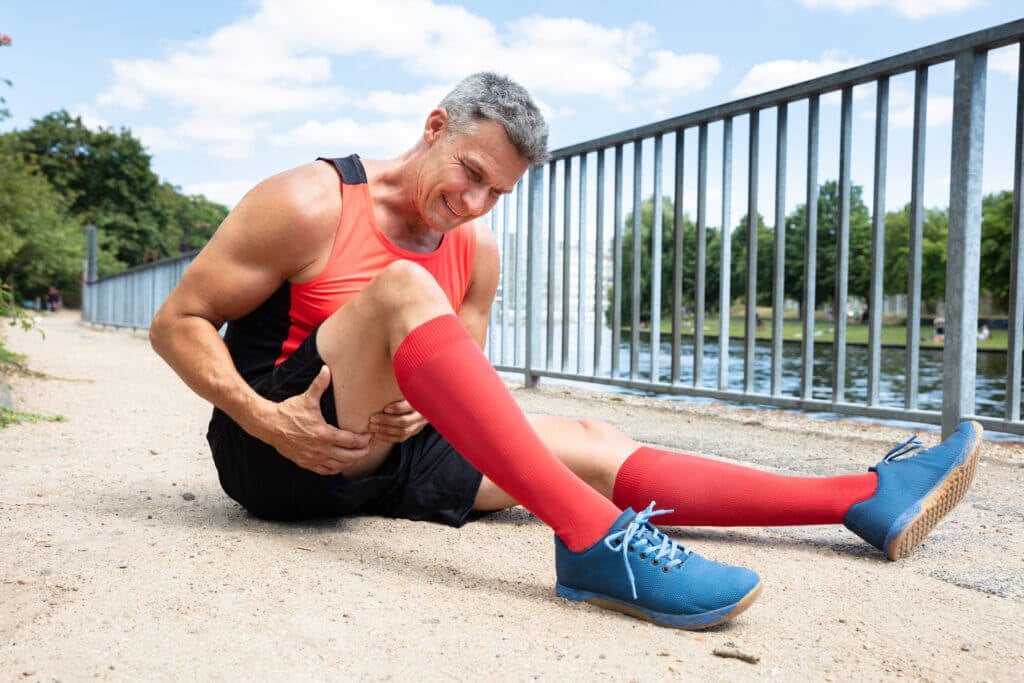Inner Thigh Cramps: Symptoms, Treatment and Prevention

A number of factors can contribute to severe leg cramps in the inner thigh. Whether you area a runner, tennis player, mountain biker, footballer, or just an active individual jogging, you will likely suffer from adductor cramps or inner thigh muscle spasms.
In order to prevent inner thigh cramps ample hydration, electrolyte replenishment, stretching, and rest. However, it’s important to note, there may be occasions where medical assistance is necessary. In this article, we’ll discuss the symptoms, treatment, and prevention of inner thigh cramps.
Symptoms of inner muscle cramps
The symptoms of cramps inside the thigh can differ depending on the cause. However, here are the the inner thigh cramp symptoms listed in no particular order:
A knot
A tingle
A sharp pain
Shooting pain
When you suffer from inner thigh cramps, you typically experience pain in the abductors or inner thigh muscles. These muscles lie close to the groin, which is the region of your hips between your thigh and stomach. Keep in mind, inner thigh pain and groin pain can overlap due to their proximity.
Other symptoms of inner thigh crams that can occur in conjunction with inner thigh cramps are as follows:
A limit in range of motion
Some irritation or inflammation
Grinding when moving
Stiffness in the muscle
Other associated symptoms can occur depending on cause
What is the cause for inner thigh cramps?
The cause of inner thigh cramps is sometimes unknown (idiopathic.) In other cases, you may often find an identifiable cause or underlying medical condition.
Unknown or Idiopathic inner thigh cramps
When the cause of idiopathic cramps is unknown, some theories can help us understand what could cause inner thigh cramps. The causes of unknown inner thigh cramps often are one of the following:
Abnormal leg muscle strain, often caused by exercising, could cause the muscles to cramp.
A sudden restriction of blood supply to the affected area.
Excessive nerve activity during sleep can lead to muscle cramping.
The shrinking of tendons due to age (Tendons are tough tissues that connect bones and muscles). When tendons shrink, they can cause the muscles attached to them to cramp. This explains why older people experience frequent leg cramps than the younger population.
Secondary leg cramps
Secondary leg cramps are often due to an identifiable cause or underlying condition. For example:
Toxins: If you have high levels of lead or mercury in your bloodstream, this can cause cramps.
Exercise: One of the leading causes of inner thigh cramps is exercise.
Infection: Occasionally, bacterial infections can cause muscle spasms and cramps.
Liver Disease: If your liver stops working efficiently, toxins start to build up in your blood. Eventually, this can cause muscle spasms and cramps.
Dehydration: In some people, low electrolytes and water levels in the body can trigger inner thigh cramps.
How to treat inner thigh cramps?
You can typically treat inner thigh cramps with self-care measures. Your physician can show you specific stretching exercises that can minimize the chances of muscle cramps. The most important thing is staying well-hydrated. However, if you have recurrent muscle cramps that impact your sleep, your doctor will probably prescribe you a muscle relaxant.
Massage and Stretch: Try to stretch the cramped muscle out and rub it gently to help it relax. If your cramp is so intense that you can’t stand, sit on the floor or in a chair and extend the affected leg. When your thigh is fully cramped, use a chair to steady yourself and bend your knee, stretching your quad and pulling your foot up towards your buttock on the affected side.
Apply Cold or Heat: Try using a heating pad or warm towel on tight or tense muscles. Also, take a hot bath or direct the water from your showerhead onto the cramped muscle. Alternatively, apply ice to the affected area.
How to prevent thigh cramps
Stretching Make sure you stretch properly before and after you exercise. Stretching, especially dynamic stretching, helps warm up your muscles and prepare them for the training you’re about to undertake. Sufficient stretching can prevent inner thigh cramps during and after exercise.
One incredible stretch for preventing cramps in the thigh, as mentioned above, is to pull your foot up towards your buttock and hold the stretch for thirty seconds. Complete this three to four times on either side after you exercise to minimize your chances of getting cramps.
Maintaining adequate levels of electrolyte balance and hydration are essential for efficient athletic performance. Therefore, it’s recommended that you drink plenty of water before, during, and after exercise. Additionally, taking an electrolyte-rich supplement to replenish depleted salts can boost your recovery and reduce your chances of cramping.
It’s vital to prioritize rehydration when exercising, as this will help you maintain fluid balance and stay cool.